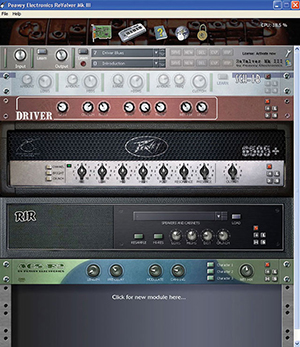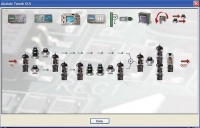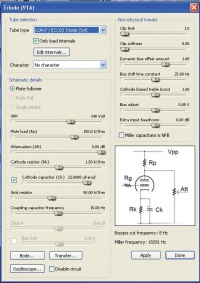Peavey Revalver MkIII
Contents |
General Information
Original Author:
Weapon: Computer Guitar Amp Simulator
Make: Peavey
Model: Revalver MarkIII
Price: 249$
Introduction
The hardware amplifier/instrument company Peavey has always been known to make good products at reasonable prizes, starting with the "Bandit" back in the seventies. But during the last 30 years they have been producing high-end instruments/amps as well. It may seem a little strange that a hardware company make's software that are emulating their own products, since if people buy the software - they don't need to buy the hardware. Probably Peavey is looking ahead/or tries to market their hardware amps through this software version. The software has been around for some years, and MarkIII was released in 2008. I figured out that especially metal-players tends to like this software, and it's quite easy to understand why.
Product description
This software contains basically 15 amp models, 9 preamps and 5 power amps, stompboxes, 11 effects and 150(!) speaker configurations. (through real-time convolution and membrane modeling) It also features 7 "utilities" that is except for the tuner additional modules that can be inserted in the signal path wherever it's desired. Modules cointaining a tube, a basic EQ, a splitter (to get two independent signal paths, which allows the software to run two different amps at the same time), frequency analyzers and more. It has two modes, normal and the 64-bit with oversampling, which actually makes a difference, the tone gets sweeter, but it takes 5 times the processor power.
The interface is simple and reminds me about Amplitubes, but in addition Peavey has made explanations for every module that can be inserted of what it actually does etc. Good! Another thing that differs the product from other simulators is that it has a plug-in slot, which let You put other VST/RTAS-plugs wherever You like in the signal path. The software model's of course Peavey's own amps but others like Mesa/Marshall/Fender are also included.
What is the most interesting with this software is a little button with a "+" -sign on it. By the first look, the simulator works most of the other one's, but if You press this button, people like me is transported directly to amplifier heaven. On every module in the software there is additional parameter behind this plus-sign. In the amps You can switch tubes, change the configurations and much more. It is like "the SIMS" for amplifiers. Actually You can build Your own virtual amp with this piece of software, the possibilities is just endless...
Another unusual thing with this software is the speaker emulation which lets You simulate the distorsion of the speaker itself. It expands the possibilities even further, though in my belief, speaker distorsion sound kinda ugly.
Otherwise it seems that Peavey didn't miss a thing in this software, except for maybe a metronome/recorder. In order to support the software, they have presets that can be downloaded from their site, which is not really necessary since there are a lot of presets included.
Sound
The Peavey software programmers really knows what they are doing, and it's easy to tell that it is an amp manufactorer that made this software. Peavey's own models sounds very good, the other's are a little bit worse. Speaking of dynamic response again (which is actually what makes these emulators differ from its role models), I must say that it is good, comparable to GR4 and Amplitube 2.1. (even that I think Amplitube Fender is best so far) This emulator is made for rock/metal freaks, I wouldn't consider to play jazz with this software. On the other hand, when You play with distorsion some of the dynamics tends to disappear anyway. A weakness may be the stompboxes, except for the Treble booster that sounds good, none of them impressed me - but on the other hand, it's possible to use Your regular pedal board in conjunction with the software. The speaker simulation is OK, but I have heard better, but also here it's possible to tweak the modules beyond imagination. Otherwise it sounds "fat", "raunchy", "brutal" and have an aggresive bite that it's competitors may lack.
Overall Impression
Peavey had in my opinion made a great piece of software here, there's no doubt that it can seriously compete with both GR4 and Amplitube 2.1. The prize is just about right, and You will get a lot for the money. I will recommend this product to all metal/hard-rock fans out there, they won't be disappointed! And even the rest of us can use it for a lot of things, since it haves the best possibilities to tweak the tone I've seen so far.
Alternative Weapon
Instead of recommending alternative weapons here, I decided to move this section to the master page for Computer Guitar Amp Simulators.
Sound/Video
Specification
64-bit amplifier modeling software.
Modules in amp head, preamp and power amp formats.
Two operation modes, with 64-bit and oversampling in HQ mode for hi-fi fanatics.
FFT based convolution reverb, including sampled spring reverb.
More than 150 speaker samples using real-time convolution and membrane modeling.
Algorithm improvements from Mk II to enhance realism, especially in the tube and transformer simulation.
Standard tuner and Simul-Tuner with six independent tuners for tuning to presets.
15 amp models.
12 pre-amplifiers.
9 power amplifiers.
19 stompboxes.
11 effects.
7 utility functions including tuners, analyzer, splitters and more.
Fully MIDI mapable.
Mac Requirements: 1 GHz CPU; 512 MB RAM; 1024x768 screen resolution; VST/AU host or sound card.
Windows Requirements: 1 GHz CPU; 512 MB RAM; 1024x768 screen resolution; VST host or ASIO/WDM sound card.








